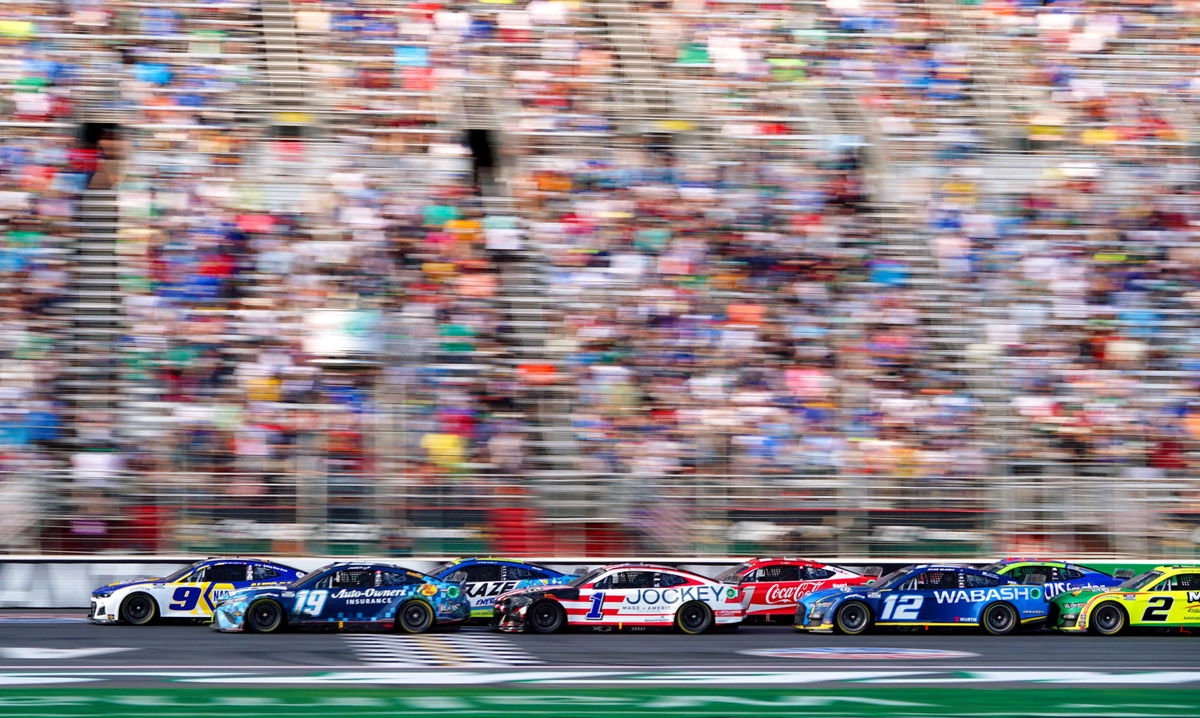
USA Today via Reuters
Jul 10, 2022; Hampton, Georgia, USA; NASCAR Cup Series driver Chase Elliott (9) and NASCAR Cup Series driver Martin Truex Jr. (19) lead the pack to a restart during the Quaker State 400 at Atlanta Motor Speedway. Mandatory Credit: John David Mercer-USA TODAY Sports TPX IMAGES OF THE DAY

USA Today via Reuters
Jul 10, 2022; Hampton, Georgia, USA; NASCAR Cup Series driver Chase Elliott (9) and NASCAR Cup Series driver Martin Truex Jr. (19) lead the pack to a restart during the Quaker State 400 at Atlanta Motor Speedway. Mandatory Credit: John David Mercer-USA TODAY Sports TPX IMAGES OF THE DAY
Since its inception, NASCAR has had several rules and regulations to police the sport and improve it. Some rules may sound complicated, while others are fairly simple. There are also a few rules which are pretty interesting and they do their part in spicing up the competition. One such rule is the Lucky Dog rule, which primarily caters to backmarker drivers. To put it in perspective, Formula One has a rule where backmarkers can un-lap themselves during a safety car period.
Watch What’s Trending Now!
In NASCAR, it works a little differently and it normally acts as a spot of respite for a driver with a compromised race. So why was the ‘lucky dog’ rule introduced in NASCAR? The main reason why the rule was in place, was in the interest of safety. Apparently, NASCAR introduced a rule where a single-lapped car can unlap itself. According to the regulation, the first driver who is one lap down gets a lap back.
READ MORE: Denny Hamlin Finds Himself Leading in an Unfortunate NASCAR Stat, Ahead of JGR Teammate Kyle Busch
What is the Lucky Dog Rule in NASCAR?
In the event that multiple drivers were a lap down, then the first of the lapped cars could regain a lap. However, if they pitted, then the rule is changed to refer to the first driver who is two laps down. There is a catch though, as the pit lane will be closed to the driver unlapping themselves. The idea here is to prevent them from getting a free pit stop.

USA Today via Reuters
May 29, 2022; Concord, North Carolina, USA; NASCAR Cup Series driver Kyle Busch (18) leads NASCAR Cup Series driver Kurt Busch (45), NASCAR Cup Series driver Bubba Wallace (23) and NASCAR Cup Series driver William Byron (24) during the Coca-Cola 600 at Charlotte Motor Speedway. Mandatory Credit: Jasen Vinlove-USA TODAY Sports
Another catch is that if the first lapped driver is the one who caused the wreck, then they cannot get their lap back. Additionally, if the said driver has a penalty for erratic driving, they will not be allowed to get their lap back. Furthermore, until 2009, the ‘lucky dog’ rule did not apply for the last 10 laps of the race. Beyond 2009 though, the first car not on the lead lap could get back their lap at any point in the race, even during the last 10 laps.
Why is it called the Lucky Dog?
The name was coined after the rule first came into effect and one driver benefitted. This occurred at the Dover International Speedway in 2003, and the recipient was Jimmy Spencer. At that time, Spencer’s car was sponsored by Sirius Satellite Radio, and the mascot was a dog. In the commentary booth, Wally Dallenbach exclaimed, “Now that is a lucky dog”, and since then, the name has stuck.
WATCH STORY: Richest NASCAR Drivers on The 2022 Grid
There were other colloquial terms for the ‘lucky dog’ rule. This included, ‘Free Pass’, ‘Wave Around’, and ‘Pardon from the Oval Office’. That last one is a cheeky reference to the old NASCAR logo and the driving standards office at any oval. Admittedly, there were some critics who felt that it was simply a lottery.
Though it is worth mentioning that since 2003, only eight drivers have got the wave around and went on to win the race. They were Ryan Newman, Mark Martin, Jeff Gordon, Kyle and Kurt Busch, Kasey Kahne, Joey Logano, and Kevin Harvick. One famous example is Kyle Busch at Watkins Glen, who lost five laps. However, owing to multiple cautions, he was able to get back on the lead lap and came close to winning.
ADVERTISEMENT
ADVERTISEMENT
ADVERTISEMENT
ADVERTISEMENT

